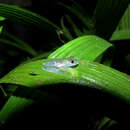Description
(
Inglês
)
fornecido por AmphibiaWeb articles
Cochranella mache males range from 22-24 mm in size while the female holotype collected was 28 mm. This species can be distinguished from others of the same genus by the following characteristics: (1) vomerine teeth present; (2) snout subacuminate when viewed dorsally and gradually inclined in lateral view; (3) eye diameter double the width of disc of Finger III; (4) tympanic annulus present; in some specimens, a weak supratympanic fold is present; (5) dorsal skin shagreened and covered with minute spinules and warts with protruding spicules, in breeding males but not in females; (6) dermal folds with white tubercles present on ventrolateral edges of finger IV, forearms, elbows, toe V, tarsi, and heels; both dermal folds and tubercles are less conspicuous on females; (7) large nuptial pad with concealed prepollex; (8) humeral spine lacking; (9) presence of white warts ornamenting cloaca; in males cloacal opening bordered laterally by n-shaped fold; in females cloacal skin flaps present but not n-shaped; (10) bones green in life; (11) hepatic peritoneum is clear or covered by small patches of white iridophores in contrast to most centrolenid species with hepatic iridophores which generally cover the entire surface; iridophores cover anterior third of parietal peritoneum, entire pericardium and visceral peritonea, and sometimes renal capsules; (12) liver with four lobe; (13) finger I greater or equal in length to finger II. Feet are webbed and hands are partially webbed (Cisneros-Heredia et al. 2008; Guayasamin and Bonaccorso 2004). The coloration of this species is unique: dorsum and ventral surfaces of limbs are blue-green; small yellow spots on the dorsum; large dull yellow patch on top of head; white iris with fine black reticulation; narrow golden ringed pupil. Moreover, the chromatic scheme can change dramatically, to a completely light blue background color with bright orange spots; the head patch now bright yellow; the iris light lavender with dark lavender reticulations; and the pupillary ring becomes a less noticeable bluish white. In males, fingers I and II and toes I and II are entirely white, while on females, only the points of fingers I and II and toes I and II are white along with the margins of the webbing (Cisneros-Heredia et al. 2008; Guayasamin and Bonaccorso 2004).The scientific name Cochranella mache refers to the type locality of the species, Montañas de Mache.
- Cisneros-Heredia, D.F., Delia, J., Yanez-Munoz, M.H., Ortega-Andrade, H.M. (2010). ''Endemic Ecuadorian glassfrog Cochranella mache is critically endangered because of habitat loss.'' Oryx, 44(1), 114-117.
- Cisneros-Heredia, D.F., Delia, J., Yánez-Muñoz, M.H., and Ortega-Andrade, H.M. (2008). ''Natural history and intraspecific variation of the Ecuadorian Blue Glassfrog Cochranella mache Guayasamin & Bonaccorso, 2004.'' Herpetozoa, 21((1/2)), 57-66.
- Guayasamin, J. M., and Bonaccorso, E. (2004). ''A new species of glass frog (Centrolenidae: Cochranella) from the lowlands of northwestern Ecuador, with comments on the Cochranella granulosa group.'' Herpetozoa, 60(4), 485-494.
Distribution and Habitat
(
Inglês
)
fornecido por AmphibiaWeb articles
These frogs occur in northwestern Ecuador in the Montañas de Mache, on vegetation close to small streams in primary and old secondary Seasonal Evergreen Forests. The holotype was collected at 510 m asl in Reserva Biológica Bilsa (Guayasamin and Bonaccorso 2004).
Life History, Abundance, Activity, and Special Behaviors
(
Inglês
)
fornecido por AmphibiaWeb articles
Cochranella mache is nocturnal and appears to be rare. A single gravid female was found at the end of the local dry season in September. Males were found perched on vegetation 1 to 1.6m above the streams while the single female was collected in the proximity of the stream, about 2.3m from the bank. Males call from the upper side of leaves overhanging streams. Eggs are attached to leaves above well-oxygenated streams where tadpoles can fall into the water. Eggs are unpigmented (Cisneros-Heredia et al. 2008; Cisneros-Heredia et al. 2010). This species can undergo dramatic color change (see Description above) (Cisneros-Heredia et al. 2008).
Life History, Abundance, Activity, and Special Behaviors
(
Inglês
)
fornecido por AmphibiaWeb articles
It occurs in at least one protected area within Ecuador, the Reserva Biológica Bilsa, within the Mache Chindul Ecological Reserve (Stuart et al. 2008).After extensive field surveys, Cisneros-Heredia et al. (2010) recently found three new localities for C. mache at Canandé, Monte Saino, and Quinindé. However, the authors recommended listing the species as Critically Endangered because of habitat loss and fragmentation, climate change in the local area due to habitat change, and decreases in abundance when compared to surveys from the 1970-1980's. The authors also note that while the species may be in decline, it could also be naturally rare or difficult to find. However, other sympatric glassfrog populations, Centrolene prosoblepon and Hyalinobatrachum fleischmanni, also show evidence of gradual declines over the last thirty years.

